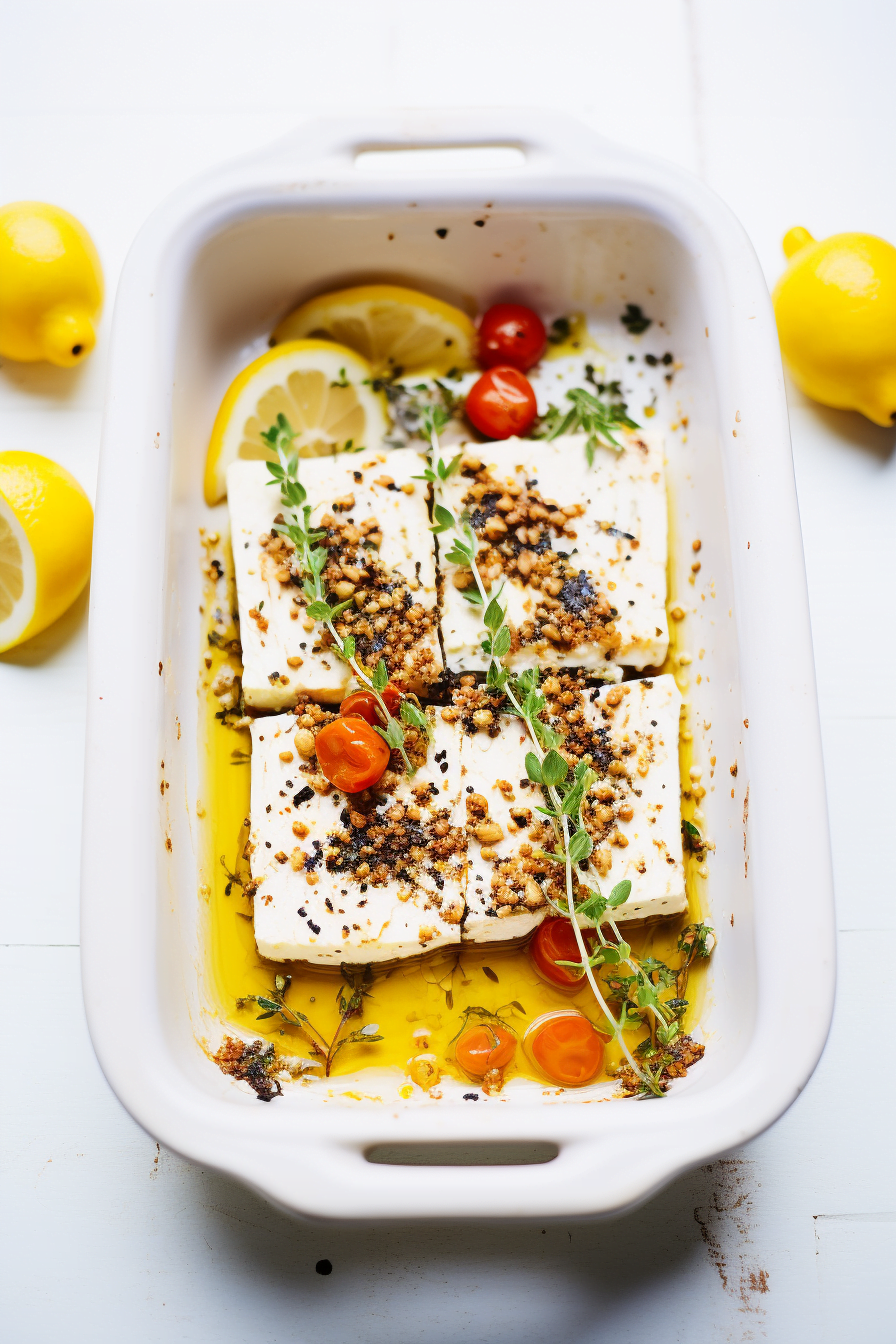Indulge in Greek Baked Feta with Honey and Thyme
Embark on a culinary journey to the heart of the Mediterranean with our Greek Baked Feta with Honey and Thyme. This dish is a celebration of simple ingredients coming together to create an explosion of flavors. Whether you’re looking to impress guests at a dinner party or indulge in a savory treat, this recipe promises to deliver an authentic Greek experience. The harmony of salty feta with the sweetness of honey and the earthiness of thyme will transport your taste buds to a seaside taverna in Greece.
Perfect for any occasion, this appetizer is not only delicious but also incredibly easy to prepare. With a preparation time of mere minutes and a cook time that allows you to mingle with your guests, you’ll find Greek Baked Feta with Honey and Thyme to be a staple in your entertaining repertoire.

The Story Behind Greek Baked Feta with Honey and Thyme
The origins of this delightful dish can be traced back to the rustic kitchens of Greece, where the art of combining simple, fresh ingredients to create flavorful dishes has been perfected over centuries. Feta cheese, a staple in Greek cuisine, is traditionally made from sheep’s milk or a mixture of sheep and goat’s milk, giving it a tangy and salty flavor that is beloved across the country.
Incorporating honey into savory dishes is a practice deeply rooted in Greek culinary traditions. Honey is revered in Greek culture, not only for its sweetness but also for its health benefits. Thyme, which grows abundantly in the Greek countryside, is a herb that has been used since ancient times, both for its aromatic qualities and its medicinal properties. The combination of these three key ingredients creates a dish that is not only a nod to the past but also a testament to the timeless appeal of Greek flavors.
The inspiration for this recipe comes from the Greek philosophy of “meraki,” which means to do something with soul, creativity, or love. When preparing this dish, one is encouraged to pour their heart into the process, ensuring that every bite is infused with passion and flavor. The Greek Baked Feta with Honey and Thyme is more than just an appetizer; it’s a reflection of the warmth and generosity that is synonymous with Greek hospitality.

Mastering the Method
The secret to perfecting Greek Baked Feta with Honey and Thyme lies in the details. Begin by selecting a high-quality block of feta cheese. The cheese should be firm to the touch, indicating freshness, and have a creamy texture that will soften beautifully in the oven. When drizzling the olive oil, ensure that it is of extra virgin quality, as this will impart a fruity and peppery note to the dish.
The art of drizzling honey over the feta is one that requires a delicate hand. Aim for a generous coating that will caramelize slightly in the oven, creating a delectable contrast to the salty cheese. As for the thyme, use only fresh leaves, as they will release their oils during baking, infusing the feta with their distinctive flavor.
When it comes to baking, the feta should be placed in the center of the oven where the heat is most consistent. Keep a watchful eye on the cheese as it bakes, looking for that golden hue that indicates it’s ready to be enjoyed. Letting the feta rest for a few minutes after baking allows the flavors to meld together, resulting in a more harmonious taste.

Variations to Savor
Herb-Infused Feta: While thyme is traditional, consider incorporating rosemary or oregano for a different herbal note. Each herb will lend a unique flavor profile to the feta, allowing you to customize the dish to your taste.
Sweet and Nutty Feta: After baking, top the feta with chopped walnuts or pistachios for a delightful crunch. The nuts will complement the sweetness of the honey and add a new textural element to the dish.
Spicy Feta Twist: For those who enjoy a bit of heat, sprinkle the feta with a pinch of cayenne pepper or diced jalapeños before baking. This will introduce a spicy kick that balances the sweetness and saltiness perfectly.
Substitutions for Dietary Needs
Lactose-Free Feta: For those with lactose intolerance, seek out lactose-free feta options that maintain the traditional flavor without the discomfort. These are often made from lactose-free cow’s milk and can be a great alternative.
Vegan Honey Alternative: If you’re adhering to a vegan diet, substitute honey with maple syrup or agave nectar. These natural sweeteners will caramelize similarly in the oven and offer a comparable sweetness.
Non-Dairy Feta: Vegan feta alternatives made from tofu or almond milk can be used in this recipe. While the taste and texture will differ, they provide a way for those avoiding dairy to enjoy a version of this classic dish.
Frequently Asked Questions
Can I use dried thyme instead of fresh? While fresh thyme is preferred for its flavor, dried thyme can be used in a pinch. Just remember to use a third of the amount, as dried herbs are more potent.
Is it possible to prepare this dish ahead of time? Yes, you can assemble the dish ahead of time and bake it just before serving to ensure it’s enjoyed warm.
What type of feta is best for this recipe? A block of Greek feta, known for its creamy yet crumbly texture, is ideal for baking.
Can I bake the feta in foil? Wrapping the feta in foil can help retain moisture, making for a softer, creamier texture upon baking.
What should I serve with Greek Baked Feta? Serve with crusty bread, fresh vegetables, or as part of a mezze platter for a complete experience.

Greek Baked Feta with Honey and Thyme
Equipment
- Ovenproof dish
- Zester
- Measuring spoons
Ingredients
- 8 oz Feta cheese block
- 2 tablespoons Extra virgin olive oil
- 3 tablespoons Honey
- 2 teaspoons Fresh thyme plus extra for garnish
- Lemon zest from 1 lemon
- Black pepper freshly ground, to taste
- 1/2 teaspoon Red pepper flakes optional, for added heat
Instructions
- Preheat your oven to 400°F (200°C).
- Place the feta cheese block in a small ovenproof dish. Drizzle with olive oil, ensuring the cheese is evenly coated.
- Generously drizzle honey over the feta, letting it cascade down the sides.
- Sprinkle the fresh thyme leaves over the cheese, ensuring even distribution for optimal flavor infusion.
- Grate lemon zest directly over the cheese for a citrusy accent.
- Add a dash of freshly ground black pepper and red pepper flakes, if using, to introduce a subtle heat.
- Bake in the preheated oven for 15 minutes, or until the feta is soft to the touch and slightly golden.
- Once baked, let it rest for a couple of minutes. Garnish with additional fresh thyme leaves.
- Serve warm with crusty bread or as part of a mezze platter.
Notes

